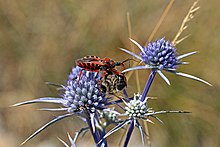Rhynocoris
| Rhynocoris | |
|---|---|

| |
| assassin bug (Rhynocoris iracundus) with bee prey | |
| Scientific classification | |
| Kingdom: | Animalia |
| Phylum: | Arthropoda |
| Class: | Insecta |
| Order: | Hemiptera |
| Family: | Reduviidae |
| Subfamily: | Harpactorinae |
| Tribe: | Harpactorini |
| Genus: | Rhynocoris Hahn, 1834 |
| Species | |
|
See Text | |
| Synonyms | |
| |
Rhynocoris annulatus looking for prey
Rhynocoris (historically often misspelled as "Rhinocoris"[1]) is a genus of assassin bug, family (Reduviidae), in the subfamily Harpactorinae. Species are recorded from Asia, mainland Europe, Africa and North America.[2]
Life history[]
Species of this genus are noted for providing parental care of offspring. Parental care is unusual in subsocial insects, having only evolved six times in the Heteroptera. R. tristis for example, is well known for guarding egg masses.[3]
Rhynocoris kumarii is known to prey upon the larvae of Euproctis fraterna (Moore).[4]
Species[]
BioLib[5] lists the following:
- (Puton, 1881)
- (Oshanin, 1870)
- Rhynocoris albopilosus (Signoret, 1858)
- Rhynocoris albopunctatus (Stål, 1855)
- Kirkaldy, 1859
- (Jakovlev, 1889)
- (Linnaeus, 1758)
- (Stål, 1866)
- Schouteden, 1929
- (Jeannel, 1916)
- Villiers, 1966
- (Stål, 1858)
- Schouteden, 1913
- Schouteden, 1929
- (Fabricius, 1781)
- (Fieber, 1861)
- (Stål, 1858)
- Miller, 1956
- (Germar, 1837)
- Miller, 1950
- (Stål, 1859)
- Villiers, 1958
- (Jeannel, 1916)
- (Jakovlev, 1877)
- (Stål, 1865)
- Villiers, 1967
- Schouteden, 1932
- (Stal, 1867)
- Bergroth, 1915
- Ribaut, 1921
- Miller, 1950
- Kiritshenko, 1926
- Schouteden, 1929
- (Reuter, 1881)
- Villiers, 1973
- (Horváth, 1892)
- (Varela, 1905)
- (Germar, 1837)
- (Linnaeus, 1767)
- (Bergroth, 1895)
- Miller, 1948
- (Jakovlev, 1889)
- (Fabricius, 1787)
- Schouteden, 1929
- Bergroth, 1894
- Linnavuori, 1989
- Dispons, 1964
- (de Carlini, 1895)
- Kirkaldy, 1881
- Schouteden, 1932
- Kolenati, 1857
- Miller, 1941
- (Stål, 1859)
- (Distant, 1903)
- Rhynocoris iracundus (Poda, 1761)
- Schouteden, 1932
- Schouteden, 1952
- Jeannel, 1916
- Miller, 1941
- Horváth, 1911
- Popov, 1964
- Ambrose & Livingstone, 1986
- Samuel & Joseph, 1953
- Rhynocoris leucospilus (Stål, 1859)
- (Reuter, 1895)
- Villiers, 1969
- Rhynocoris longifrons (Stål, 1874)
- Miller, 1956
- Miller, 1956
- Miller, 1954
- Villiers, 1952
- Distant, 1909
- Rhynocoris marginatus (Fabricius, 1794)
- (Fabricius, 1803)
- Schouteden, 1929
- (Stal, 1867)
- Miller, 1948
- Kiritschenko, 1913
- Schouteden, 1944
- Miller, 1941
- (Oshanin, 1870)
- Villiers, 1948
- Bergroth, 1912
- Miller, 1950
- Miller, 1950
- Miller, 1941
- (Herrich-Schäffer, 1842)
- (Reuter, 1881)
- Distant, 1903
- (Fabricius, 1781)
- Samuel & Joseph, 1953
- (Palisot de Beauvois, 1805)
- Dispons, 1964
- Benedek, 1969
- Miller, 1950
- Hesse, 1925
- Schouteden, 1929
- China & Miller, 1950
- (Jakovlev, 1877)
- Hesse, 1925
- Villiers, 1964
- (Distant, 1892)
- (Jakovlev, 1877)
- (Herrich-Schaeffer, 1848)
- (Distant, 1903)
- (Stål, 1855)
- Miller, 1954
- (Distant, 1879)
- (Bergroth, 1890)
- Rhynocoris rubricus (Germar, 1814)
- Miller, 1954
- (Horváth, 1879)
- Miller, 1956
- (Fallou, 1891)
- (Bolivar, 1879)
- (Thunberg, 1822)
- (Stål, 1865)
- Villiers, 1948
- (Germar, 1837)
- (Reuter, 1881)
- (Jeannel, 1916)
- (Oshanin, 1870)
- Distant, 1904
- Villiers, 1948
- Schouteden, 1910
- (Jeannel, 1916)
- Hoberlandt, 1951
- (Reuter, 1881)
- Rhynocoris tristis (Stål, 1855)
- (Reuter, 1877)
- (Herrich-Schaeffer, 1848)
- Schouteden, 1932
- (Paiva, 1918)
- Rhynocoris ventralis (Say, 1832)
- (Stål, 1855)
- (Schouteden, 1910)
- (Germar, 1837)
- (Stål, 1859)
- (Germar, 1837)
- Miller, 1950
- Schouteden, 1944
- Schouteden, 1929
- (Kirkaldy, 1909)
- (Distant, 1890)
- (de Carlini, 1895)
Gallery[]

Rhynocoris annulatus

Rhynocoris cuspidatus

Rhynocoris erythropus

Rhynocoris iracundus
Rhynocoris punctiventris
Rhynocoris rubricus
References[]
- ^ Parker, A.H. (1969). The predatory and reproductive behaviour of Rhinocoris bicolor and R. tropicus (HEMIPTERA: REDUVIIDAE). Entomologia Experimentalis et Applicata, 1969, 12: 107-117
- ^ GBIF: Rhynocoris Hahn, 1833
- ^ Beal, Christy A. & Tallamy, Douglas W. (July 2006). "A new record of amphisexual care in an insect with exclusive paternal care: Rhynocoris tristis (Heteroptera: Reduviidae)". Journal of Ethology. 24 (3): 305–307. doi:10.1007/s10164-005-0190-2.
- ^ Ambrose, Dunston P.; Rajan, S. Jesu & Raja, J. Micheal (2008). "Functional response of Rhynocoris kumarii Ambrose and Livingstone and normal and synergy-505 exposed Rhynocoris marginatus (Fab.) to larva of Euproctis fraterna (Moore)". Indian Journal of Entomology. 70 (3): 206–216.
- ^ BioLib.cz Taxon profile: genus Rhynocoris Hahn, 1833 (retrieved 13 May 2020)
Categories:
- Reduviidae
- Heteroptera genera






